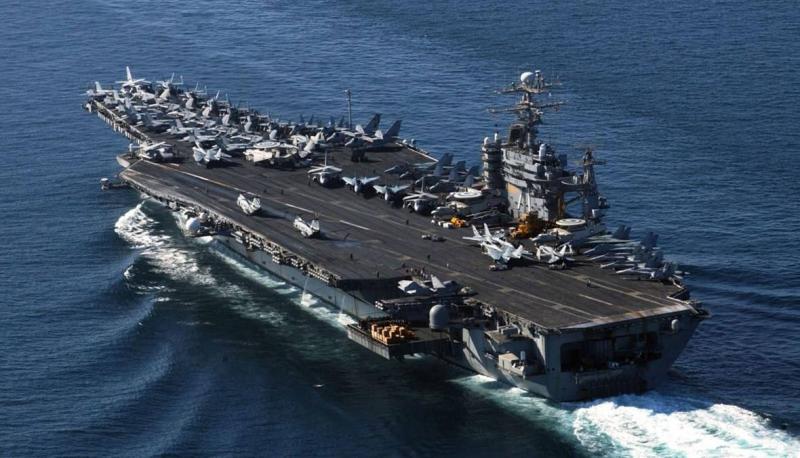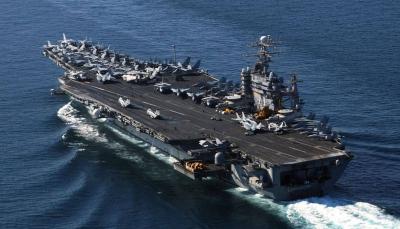As of 2024, the United States operates 11 active aircraft carriers. These include various types such as nuclear-powered carriers from the "Nimitz" and "Ford" classes, as well as "Wasp" class carriers that carry helicopters.
The South Korean Navy announced that the American nuclear-powered aircraft carrier "Theodore Roosevelt" arrived in the coastal city of Busan, South Korea, today, Saturday, to conduct joint military exercises this month with the host nation and Japan. The visit comes seven months after another American aircraft carrier, the "Carl Vinson," made a trip to South Korea as a show of extended deterrence against North Korea's nuclear and missile programs.
## Importance of "Theodore Roosevelt" in the U.S. Fleet
"USS Theodore Roosevelt" is the fourth aircraft carrier of the "Nimitz" class in the U.S. Navy, named in honor of Theodore Roosevelt, the 26th president of the United States. It is also the fourth ship to carry the name Theodore Roosevelt, three of which bear his full name, while the fourth carries only his last name, according to information published on Wikipedia.
### Design, Construction, and Operational Start
"Theodore Roosevelt" was the first aircraft carrier assembled using modular construction, where large units are built independently in "positioned" areas before being raised into place and welded together. It also has minor structural differences from earlier carriers such as "USS Nimitz," "USS Dwight D. Eisenhower," and "USS Carl Vinson," with improved protection for ammunition storage aboard.
After sea trials, "Theodore Roosevelt" commenced its first deployment on December 30, 1988, patrolling the Mediterranean Sea before returning on June 30, 1989. It received the "Battle "E" Award for 1989 from the Commander of the U.S. Atlantic Fleet on March 20, 1990.
### Participation in Operations
On December 28, 1990, it participated in Operation Desert Shield, arriving in the Arabian Gulf on January 16, 1991. As Operation Desert Storm commenced, it engaged in combat operations, conducting over 4,200 sorties, the highest of any aircraft carrier, dropping more than 4.8 million pounds (2,177,243.4 kg) of munitions before the ceasefire on February 28 of the same year.
Following the September 11, 2001 attacks, it began its seventh deployment with Carrier Air Wing One on October 15, 2001, entering the Northern Arabian Sea to join the "Enterprise" and "Carl Vinson" already present in launching attacks against Al-Qaeda in Afghanistan during Operation Enduring Freedom.
### Record-Breaking Deployment
In 2002, "Theodore Roosevelt" spent a consecutive 160 days at sea, breaking the record for the longest continuous deployment of an aircraft carrier since World War II. It returned home on March 27, 2002, receiving the Navy Unit Commendation, the Battenberg Cup for 2001, and the "E" Award for 2001.
It can accommodate 5,000 personnel and provides most services, resembling a small town at sea, including dining, banking services, ATMs, laundry, mail facilities, shopping, and barber services. It is considered a marvel of modern technology and engineering, serving as a powerful asset for the nation, capable of sustaining itself at sea for several months at a time. It is designed to execute the missions of the U.S. Navy today and into the 21st century, according to the U.S. Navy's website.
### Advanced Radar and Missile Systems
At the heart of the ship is the Aegis Weapons System, an integrated radar and missile system capable of simultaneous operations for defense against advanced air and ground threats. It can operate independently or as part of a naval force, coalition, or allied forces.
One of its distinctive features is its size and outstanding capabilities, measuring 1,092 feet long, making it one of the largest warships ever built, with a flight deck covering an area of four acres. It can accommodate over 60 aircraft, including fighter jets, helicopters, and other support aircraft. Supported by a nuclear propulsion system, it provides range and endurance, representing a formidable presence at sea.
### Modern Navigation Systems and GPS
Equipped with the latest in maritime engineering, it features radar systems like the AN/SPY 1D radar, enhancing air defense capabilities. The carrier also includes communication systems to coordinate with other naval assets and allied forces.
Furthermore, it boasts navigational systems, such as Global Positioning System (GPS) and inertial navigation, ensuring precise location tracking and control of its course. The ship carries RIM-7 Sea Sparrow and RIM-162 Evolved Sea Sparrow missiles, significantly enhancing its air defense capabilities. Additionally, it is equipped with the Phalanx Close-In Weapon System (CIWS), serving as a line of defense against ships' missiles and aircraft.
A notable technological advancement of "USS Theodore Roosevelt" is its nuclear propulsion system. Thanks to energy generated from two nuclear reactors, the ship can operate continuously for over 20 years without the need for refueling, providing unmatched endurance and range. This propulsion system also allows the carrier to reach speeds exceeding 30 knots, enabling deployment and maneuverability.
The advanced air traffic management systems onboard facilitate operations on the flight deck, including four steam catapults known as the Electromagnetic Aircraft Launch System (EMALS), which provide acceleration for launching aircraft.




